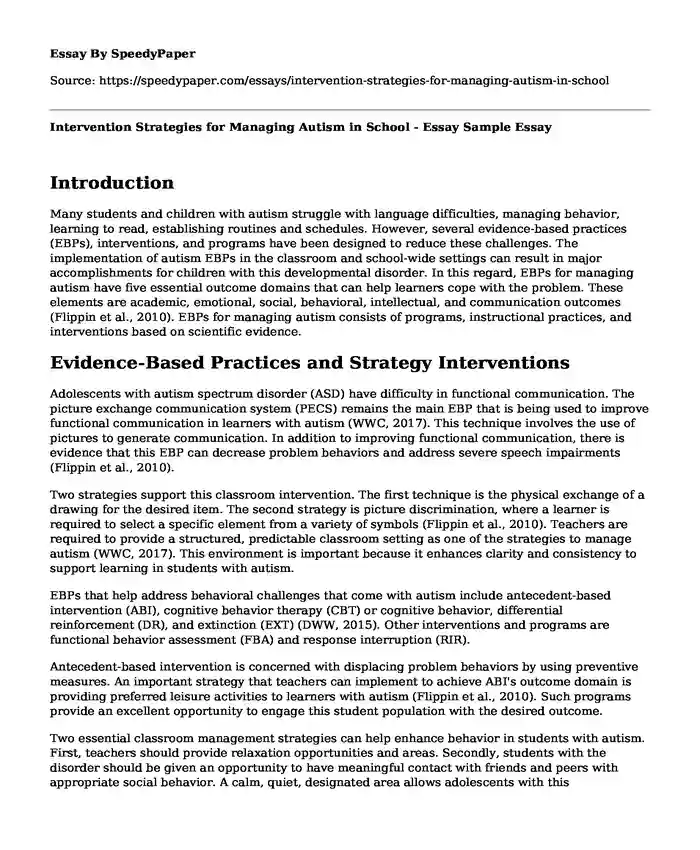Introduction
Many students and children with autism struggle with language difficulties, managing behavior, learning to read, establishing routines and schedules. However, several evidence-based practices (EBPs), interventions, and programs have been designed to reduce these challenges. The implementation of autism EBPs in the classroom and school-wide settings can result in major accomplishments for children with this developmental disorder. In this regard, EBPs for managing autism have five essential outcome domains that can help learners cope with the problem. These elements are academic, emotional, social, behavioral, intellectual, and communication outcomes (Flippin et al., 2010). EBPs for managing autism consists of programs, instructional practices, and interventions based on scientific evidence.
Evidence-Based Practices and Strategy Interventions
Adolescents with autism spectrum disorder (ASD) have difficulty in functional communication. The picture exchange communication system (PECS) remains the main EBP that is being used to improve functional communication in learners with autism (WWC, 2017). This technique involves the use of pictures to generate communication. In addition to improving functional communication, there is evidence that this EBP can decrease problem behaviors and address severe speech impairments (Flippin et al., 2010).
Two strategies support this classroom intervention. The first technique is the physical exchange of a drawing for the desired item. The second strategy is picture discrimination, where a learner is required to select a specific element from a variety of symbols (Flippin et al., 2010). Teachers are required to provide a structured, predictable classroom setting as one of the strategies to manage autism (WWC, 2017). This environment is important because it enhances clarity and consistency to support learning in students with autism.
EBPs that help address behavioral challenges that come with autism include antecedent-based intervention (ABI), cognitive behavior therapy (CBT) or cognitive behavior, differential reinforcement (DR), and extinction (EXT) (DWW, 2015). Other interventions and programs are functional behavior assessment (FBA) and response interruption (RIR).
Antecedent-based intervention is concerned with displacing problem behaviors by using preventive measures. An important strategy that teachers can implement to achieve ABI's outcome domain is providing preferred leisure activities to learners with autism (Flippin et al., 2010). Such programs provide an excellent opportunity to engage this student population with the desired outcome.
Two essential classroom management strategies can help enhance behavior in students with autism. First, teachers should provide relaxation opportunities and areas. Secondly, students with the disorder should be given an opportunity to have meaningful contact with friends and peers with appropriate social behavior. A calm, quiet, designated area allows adolescents with this developmental disorder to participate in repetitive activities that have a calming effect. Such an environment helps manage autism in learners craving self-stimulating behaviors and certain repetitive movements.
Evidence-based interventions to enhance skills in this student population include peer-mediated instruction (PMI), pivotal response training (PRT), self-management (SM), and social skills training (SST) (DWW, 2015). Examples of strategies that teachers can implement in school settings include having socially competent friends act as role models for learners with the disorder and training peers to prompt or reinforce desired behaviors. Besides, teachers need to minimize sensory factors' adverse impacts on this student population (WWC, 2017).
Conclusion
Evidence-based practices can help address emotional, academic, social, behavioral, and communication challenges in students with autism. There are several strategies for managing autism that teachers can implement to achieve the desired outcomes. Some of them are providing relaxation opportunities and addressing instructional activities that cause frustration. It is also necessary to identify and correct sensory factors that disrupt students with autism in class.
References
Flippin, M., Reszka, S., & Watson, L. R. (2010). Effectiveness of the picture exchange communication system (PECS) on communication and speech for children with autism spectrum disorders: A meta-analysis. American Journal of Speech-Language Pathology, 19(2), 178-195. https://doi.org/10.1044/1058-0360(2010/09-0022)
DWW. (2015). Autism interventions: Evidence-based practices https://ncaep.fpg.unc.edu/sites/ncaep.fpg.unc.edu/files/imce/documents/NCAEP%20Report%20-%20Table%203.1%20-%20EBP%20list.pdf
WWC. (2017). Autism and evidence-based practices. https://ies.ed.gov/ncee/wwc/
Cite this page
Intervention Strategies for Managing Autism in School - Essay Sample. (2023, Dec 25). Retrieved from https://speedypaper.net/essays/intervention-strategies-for-managing-autism-in-school
Request Removal
If you are the original author of this essay and no longer wish to have it published on the SpeedyPaper website, please click below to request its removal:
- Essay Sample for Everyone, Treatment for Autistic Children
- Free Essay about the Behavior of Children on the Autism Spectrum
- Free Essay Example: Eating Disorders
- Generalized Anxiety Disorders. Essay Example
- Impulsive Teenagers: A Case Study of Personality Disorders
- Paper Sample: Strong Recommendation for Son's MSc in MBIT at Sheffield University
- Navigating Ethical Dilemmas: College Students and the Social Media Conundrum - Paper Sample
Popular categories





